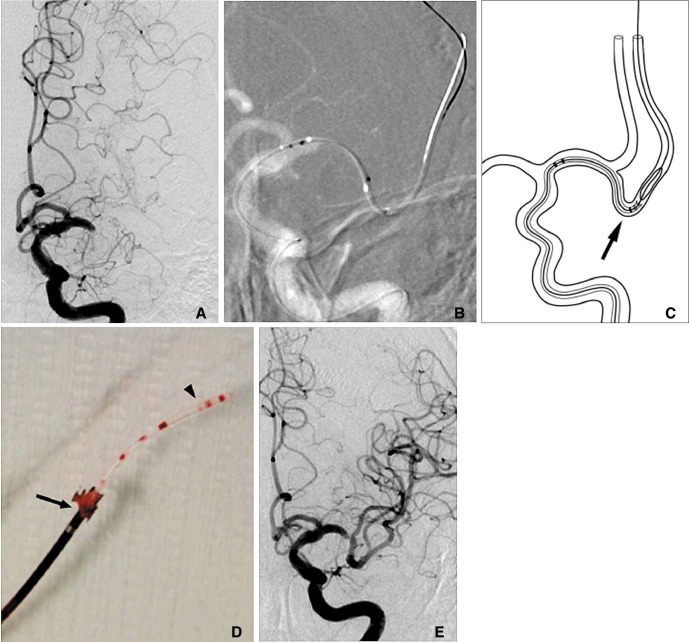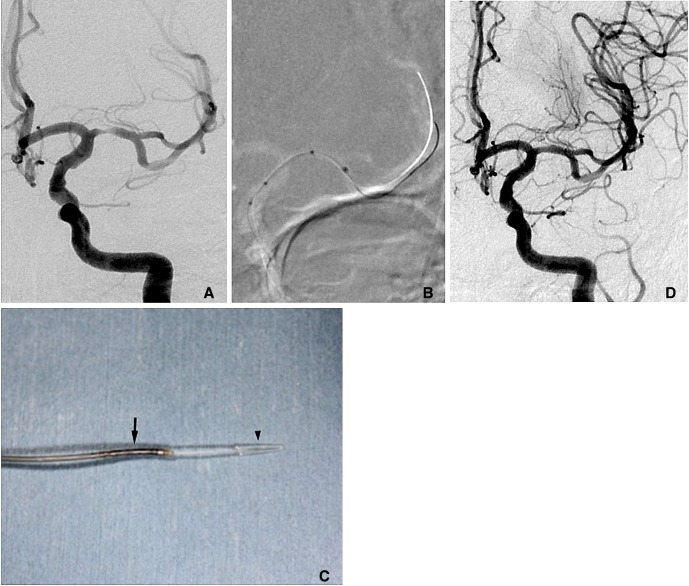Neurointervention.
2012 Sep;7(2):102-108. 10.5469/neuroint.2012.7.2.102.
Mechanism of Procedural Failure Related to Wingspan
- Affiliations
-
- 1Department of Radiology and Research Institute of Radiology, University of Ulsan, College of Medicine, Asan Medical Center, Seoul, Korea. dcsuh@amc.seoul.kr
- 2Department of Radiology, First Affiliated Hospital of Nanjing Medical University, Nanjing, China.
- KMID: 1841096
- DOI: http://doi.org/10.5469/neuroint.2012.7.2.102
Abstract
- PURPOSE
Wingspan is the only FDA approved self-expanding stent for intracranial artery and known to have better delivery compared to balloon expandable stent. However, some delivery failure has been reported but incidence and mechanism of the failure have not been completely elucidated. We present the cause and mechanism of Wingspan deployment failure experienced in our Institute.
MATERIALS AND METHODS
We experienced deployment failure in seven patients (8.8%) out of 80 patients who underwent Wingspan stenting since 2007. Mean age of the patients was 62 (range 47~78) and male to female ratio was 6:1. We evaluated the cause and mechanism why the deployment was not successful and how we could manage it subsequently.
RESULTS
We categorized failures occurred in seven patients into three categories: delivery failure (n = 3), deployment failure of stent (n = 3), retrieval failure of dual tapered (olive) tip of the inner body through the deployed the stent (n = 1). The technical failure in using Wingspan stent (delivery, deployment and retrieval failures) are related to tortuousness of the proximal (n =4) as well as distal (n =1) cerebral vessels to the stenotic lesion and bulky profile of the olive tip (n =2).
CONCLUSION
The technical failure in using Wingspan stent (delivery, deployment and retrieval failures) are related to tortuousness of the proximal as well as distal cerebral vessels to the stenotic lesion and bulky profile of the olive tip. To avoid device-related complication, complete understanding of the stent design is mandatory before using the stent.
Figure
Cited by 3 articles
-
Recent Update of Guidelines for Neurointerventional Procedures
Shang Hun Shin, Soon Chan Kwon, Dae Chul Suh
Neurointervention. 2013;8(2):68-72. doi: 10.5469/neuroint.2013.8.2.68.Preliminary Experience of Neuroform Atlas Stenting as a Rescue Treatment after Failure of Mechanical Thrombectomy Caused by Residual Intracranial Atherosclerotic Stenosis
Ho Jun Yi, Jae Hoon Sung, Dong Hoon Lee
J Korean Neurosurg Soc. 2021;64(2):198-206. doi: 10.3340/jkns.2020.0146.Usefulness of Self-Expandable Stent for Recanalization of Intracranial Atherosclerotic Disease: Preliminary Experience with Enterprise Stent
Woo Sang Jung, Sam-Soo Kim, Kyung-Yul Lee, Sang Hyun Suh
Neurointervention. 2022;17(1):37-44. doi: 10.5469/neuroint.2022.00017.
Reference
-
1. Suh DC, Kim JL, Kim EH, Kim JK, Shin JH, Hyun DH, et al. Carotid baroreceptor reaction after stenting in 2 locations of carotid bulb lesions of different embryologic origin. AJNR Am J Neuroradiol. 2012; 33:977–981. PMID: 22268083.
Article2. Suh DC, Ko YB, Park ST, Yoon KH, Lim OK, Oh JS, et al. Computational flow dynamics of the severe M1 stenosis before and after stenting. Neurointervention. 2011; 6:13–16. PMID: 22125742.
Article3. Lu PH, Park JW, Park S, Kim JL, Lee DH, Kwon SU, et al. Intracranial stenting of subacute symptomatic atherosclerotic occlusion versus stenosis. Stroke. 2011; 42:3470–3476. PMID: 21940974.
Article4. Park ST, Kim JK, Yoon KH, Park SO, Park SW, Kim JS, et al. Atherosclerotic carotid stenoses of apical versus body lesions in high-risk carotid stenting patients. AJNR Am J Neuroradiol. 2010; 31:1106–1112. PMID: 20093309.
Article5. Suh DC, Lee SH, Kim KR, Park ST, Lim SM, Kim SJ, et al. Pattern of atherosclerotic carotid stenosis in Korean patients with stroke: different involvement of intracranial versus extracranial vessels. AJNR Am J Neuroradiol. 2003; 24:239–244. PMID: 12591640.6. Choi JW, Kim JK, Choi BS, Lim HK, Kim SJ, Kim JS, et al. Angiographic pattern of symptomatic severe M1 stenosis: comparison with presenting symptoms, infarct patterns, perfusion status, and outcome after recanalization. Cerebrovasc Dis. 2010; 29:297–303. PMID: 20090322.
Article7. In HS, Lee HY, Park JY, Kim SY, Jung JH, Kim JS, et al. Intracranial stenting in patients with atherosclerotic stenosis associated with various aneurysms in the same diseased arterial segment. AJNR Am J Neuroradiol. 2010; 31:1895–1898. PMID: 20671060.
Article8. Suh DC, Kim JK, Choi JW, Choi BS, Pyun HW, Choi YJ, et al. Intracranial stenting of severe symptomatic intracranial stenosis: results of 100 consecutive patients. AJNR Am J Neuroradiol. 2008; 29:781–785. PMID: 18310234.
Article9. Pyun HW, Suh DC, Kim JK, Kim JS, Choi YJ, Kim MH, et al. Concomitant multiple revascularizations in supra-aortic arteries: short-term results in 50 patients. AJNR Am J Neuroradiol. 2007; 28:1895–1901. PMID: 17921235.
Article10. Suh DC, Kim EH. The therapeutic time window related to the presenting symptom pattern, that is, stable versus unstable patients, can affect the adverse event rate of intracranial stenting. Stroke. 2009; 40:e588–e589. author reply e590. PMID: 19745184.
Article11. Bose A, Hartmann M, Henkes H, Liu HM, Teng MM, Szikora I, et al. A novel, self-expanding, nitinol stent in medically refractory intracranial atherosclerotic stenoses: the Wingspan study. Stroke. 2007; 38:1531–1537. PMID: 17395864.12. Gao X, Liang G, Li Z, Wei X, Wang X, Zhang H, et al. Wingspan stent-assisted coiling of intracranial aneurysms with symptomatic parent artery stenosis: experience in 35 patients with mid-term follow-up results. Eur J Radiol. 2012; 81:e750–e756. PMID: 22381442.
Article13. Chiam PT, Samuelson RM, Mocco J, Hanel RA, Siddiqui AH, Hopkins LN, et al. Navigability trumps all: stenting of acute middle cerebral artery occlusions with a new self-expandable stent. AJNR Am J Neuroradiol. 2008; 29:1956–1958. PMID: 18768730.
Article14. Costalat V, Maldonado IL, Vendrell JF, Riquelme C, Machi P, Arteaga C, et al. Endovascular treatment of symptomatic intracranial stenosis with the Wingspan stent system and Gateway PTA balloon: a multicenter series of 60 patients with acute and midterm results. J Neurosurg. 2011; 115:686–693. PMID: 21740123.
Article15. Fiorella D, Levy EI, Turk AS, Albuquerque FC, Niemann DB, Aagaard-Kienitz B, et al. US multicenter experience with the wingspan stent system for the treatment of intracranial atheromatous disease: periprocedural results. Stroke. 2007; 38:881–887. PMID: 17290030.
Article16. Levy EI, Siddiqui AH, Crumlish A, Snyder KV, Hauck EF, Fiorella DJ, et al. First Food and Drug Administration-approved prospective trial of primary intracranial stenting for acute stroke: SARIS (stent-assisted recanalization in acute ischemic stroke). Stroke. 2009; 40:3552–3556. PMID: 19696415.17. Zaidat OO, Wolfe T, Hussain SI, Lynch JR, Gupta R, Delap J, et al. Interventional acute ischemic stroke therapy with intracranial self-expanding stent. Stroke. 2008; 39:2392–2395. PMID: 18556584.
Article18. Lee DH, Daza OD, Arat A, Mawad ME. The WingSpan stent system for the treatment of intracranial atherosclerotic stenoses: a single center experience. Neurointervention. 2009; 4:87–93.19. Suh DC, Kim SJ, Lee DH, Kim W, Choi CG, Lee JH, et al. Outcome of endovascular treatment in symptomatic intracranial vascular stenosis. Korean J Radiol. 2005; 6:1–7. PMID: 15782013.
Article20. Yu SC, Leung TW, Lee KT, Hui JW, Wong LK. Angioplasty and stenting of atherosclerotic middle cerebral arteries with Wingspan: evaluation of clinical outcome, restenosis, and procedure outcome. AJNR Am J Neuroradiol. 2011; 32:753–758. PMID: 21436335.
Article21. Kim JK, Choi JW, Choi BS, Kim TI, Whang SM, Kim SJ, et al. Sum of the Curve Indices for Estimating the Vascular Tortuousness of the Internal Carotid Artery. Neurointervention. 2009; 4:101–106.
- Full Text Links
- Actions
-
Cited
- CITED
-
- Close
- Share
- Similar articles
-
- Wingspan Stenting for Symptomatic Severe In-Stent Stenosis of a Closed-Cell Stent after Stent-Assisted Coiling of a Ruptured Intracranial Aneurysm
- Coincidental Occurrence of Acute In-stent Thrombosis and Iatrogenic Vessel Perforation During a Wingspan Stent Placement: Management with a Stent In-stent Technique
- Delayed Remote Intracerebral Hemorrhage after Wingspan Stenting for Internal Carotid Artery Stenosis Following the On-Label Usage Guidelines
- The WingSpan Stent System for the Treatment of Intracranial Atherosclerotic Stenoses: A Single Center Experience
- Relationship between the auditory P300 and the procedural memory function in drug-naive patients with Parkinson's disease



